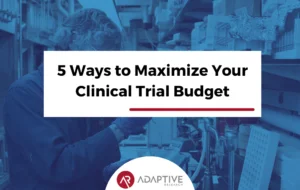In the world of clinical research, certain practices will lead to effective collaborations between the sponsor and the site. It is important to plan, organize, and execute clinical trials in a way that minimizes inconsistencies due to differences in study design, participant characteristics, and clinical trial specifications. Many of the pitfalls encountered by trial sponsors that lead to inconsistent results are preventable. The following best practices can help you reduce these common errors and ensure that your trial is conducted in a consistent manner.
Minimize Subject and Site Variation
Reduce the amount of variability between your sites as much as possible. For example, if you’re conducting a cardiovascular clinical trial with multiple sites, create one set of inclusion/exclusion criteria that applies to all sites within the study. This will help reduce inconsistencies and increase productivity by eliminating redundant explanations during training and certification. You should also minimize your site clientele. If you have an extensive participant population or numerous treatment arms for single-site studies, it is best to divide these types of trials into two separate studies. It is important to note that any changes made before the first screening visit requires a new protocol submission and approval process from the FDA. Additionally, deviations from your clinical trial agreement (CTA) will need to be addressed and approved by the sponsor and FDA before implementation.
During study set-up, you must provide a detailed site profile that includes: Site Name, Company Name, Address, Contact Person(s), Phone Number(s), and FAX Number(s). You should also include the following: contact email address, website address, descriptions of your clinical trial-related tasks such as randomization/treatment allocation, data entry/quality control coordination, patient follow-up, and names of key personnel responsible for each task.
Share Enrollment Updates Regularly
Enrollment is a dynamic process, and the information you provide to your sponsor should be as up-to-date as possible. Because of site activities, patient flow, and patient status changes, we recommend you send enrollment updates at least once per week (more frequently if there are issues such as slow or sporadic recruitment, patients dropping out because of side effects, etc.)
Communication with the Sponsor Is Essential
All clinical trial sites need to establish an open dialogue about what they need from the sponsor early on. We encourage our clients to use their CTAs as a guide for this conversation. A good CTA should specify a timeline for a first meeting/conference call between key personnel before starting the first patient.
Involve Sites For Better Trial Design
As many of you may know, we often work with the sponsor on trial design and protocol modifications. This is one area where it’s important to involve sites early. If sites don’t provide feedback for changes in how they’ll conduct their study (i.e., site visits instead of central reading, etc.), then trials can go off track and become difficult to manage and keep on time and budget.
Data Quality As Part Of The Trial Plan
We encourage sponsors to plan data quality activities as part of the overall clinical development strategy –a good CT does this by including a data verification plan as part of its data management plan. A DVP should include the following elements:
- who will be responsible for delivery
- when it will be delivered
- how it will be verified
- what will constitute satisfactory verification
We’d like to see the DVP incorporated into a broader data management plan – with plans for ongoing monitoring of site-level performance, impact on data quality, and overall study stability. For example, there are good reasons why sites are selected that should be described in their ability to follow or not follow the protocol requirements. If these issues are not considered upfront, they can lead to delays during the conduct of the trial. The same applies if you’re changing your primary outcome halfway through a clinical development plan –sites need time to change their systems, so they go back and look at all the work they’ve already done on your new outcome measure. Sponsors should avoid sending the site’s “bad” data.
If data is inaccurate or incomplete, it can be difficult for both sponsor and site to know whether the incorrect entry was the site’s error or sponsor’s error. Sites have neither the time nor expertise to work on problems beyond their control, so this becomes a question of which party is responsible for poor data quality.
To avoid this issue, several companies have implemented a Quality Control (QC) process in their trial management systems that automatically checks for data problems and alerts the Sponsor when a problem has been found. With this QC program, you know about errors early and can fix them before they become a barrier between your company and its clinical sites.
It’s important that both parties proactively find solutions for these challenges by building strong, open communication channels across functions with cross-functional boundaries. In many cases, once stakeholder issues are identified at one site, it often becomes apparent other sites are having similar issues,
Provide Feedback to Sites
Finally, consider soliciting feedback from your clinical sites about what they need to make their work successful. In many cases, access to high-quality, high-volume billers and coders is a top concern for practices in addition to leveraging electronic data submission when available.
In Summary
The best opportunity for success between sponsor and site relates directly to the core foundation of a Clinical Trial Agreement or client contract. You should have documented agreement on all roles and responsibilities by both parties. Because that document also defines how issues will be handled going forward, all questions about the agreement must be addressed before any problems arise in the relationship. Collaboration is key in any good business relationship, whether it be with sites or vendors. When you take time upfront at contract negotiation, during training, for periodic site visits and other communication opportunities to define expectations, identify roles and responsibilities, it will help ensure that your relationship between sites and sponsors runs smoothly.






